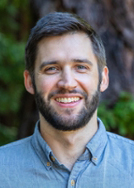
Overall, my lab is interested in defining host determinants of disease severity following respiratory viral infections. We’re particularly interested in the role that lung fibroblasts, and other mesenchymal cells, play in regulating disease severity during both acute and post-viral stages of disease. There has been some very exciting recent work uncovering the diversity of fibroblasts in distinct locations in the respiratory tract, and we’re interested in defining the responses of these different cell lineages to viral infections and associated inflammation and damage.
When did you start your lab?
I started my lab at the University of California Santa Cruz in the Department of Molecular, Cell, & Developmental Biology in July 2021. After accepting the position in summer 2020, I deferred my start date for a year due to pandemic-related concerns. The entire interview process was done virtually, and the first time I stepped onto the beautiful campus in Santa Cruz was my first day on the job.
Where did you do your postdoc/fellowship?
I did my postdoc in the Department of Immunology at St. Jude Children’s Research Hospital in Memphis, TN. It was a fantastic intellectual environment. I also really benefited from collaborations with colleagues in the Department of Infectious Diseases and the Influenza Group at St. Jude.
What genetics/genomics techniques do you utilize in your lab?
We use single cell genomics and spatial transcriptomics to study the transcriptional responses of individual lung cells to influenza virus infection and the organization of these responses in the tissue.
At what point in your life did you decide you wanted to be a scientist/physician?
Although I’ve been interested in biology since high school, I really decided that I wanted a career in biomedical research after undergrad while I was serving as a US Peace Corps Volunteer in Peru. I was working closely with local health workers on vaccination campaigns as a public health promoter in a small town in the northern Andes Mountains. Even though I was far away from a research lab, I became inspired by the idea of doing research to develop tools for public and individual health interventions, such as vaccines. I applied to graduate schools from Peru and soon after started my scientific career in infectious disease research.
Briefly describe the publication most important to establishing your new lab (with a PMID, preprint link, or reference) in general-audience terms and include where you were in your career when it was published.
A publication from my postdoc titled “Exuberant fibroblast activity compromises lung function via ADAMTS4” (PMID: 33116313) has laid the foundation for starting my own lab. In this study, we identified lung fibroblasts as crucial regulators of immunopathology and compromised lung function following severe influenza virus infection. We defined a potential mechanism by which lung fibroblasts remodel the extracellular matrix, via the activity of the protease ADAMTS4, to promote immune cell infiltration, which drives severe disease after infection. Through a large collaborative effort, for which I am very grateful, we were able to analyze respiratory samples from three independent human cohorts and demonstrate that ADAMTS4 is a predictor of influenza disease severity. I think that extracellular matrix remodeling is just one of the many important functions of fibroblasts in response to respiratory infections, and we’re excited to explore other mechanisms by which they interact with other cells in the lung and regulate their activities.
How long have you been a member of ATS?
I have been a member of ATS since 2018.
What assemblies do you think you most benefit from and will contribute back to?
I think that I benefit most from the Assemblies on Pulmonary Infections and Tuberculosis and Allergy, Immunology, and Inflammation.
What is your favorite aspect of ATS?
My favorite aspect of ATS is the opportunities for collaborations across clinical and basic research and the endless ways to learn about research related to respiratory health from the annual meeting to the Webinar Journal Clubs hosted by various ATS assemblies.
How could your research assist scientists and clinicians in other assemblies at ATS?
One of the main goals of our research is to identify host determinants and predictors of respiratory virus disease severity. We primarily use in vitro cellular models and in vivo animal models of infection, but we hope that uncovering new biology in these models will provide clinicians and clinical researchers with promising therapeutic targets to pursue in human studies.
Would you be open to collaborations with GG and/or non-GG scientists and clinicians? Do you have any potential lab openings currently or in the near future?
We would love to collaborate with GG and non-GG scientists and clinicians. Please get in touch if you are interested in our work. My email is: dfboyd@ucsc.edu



